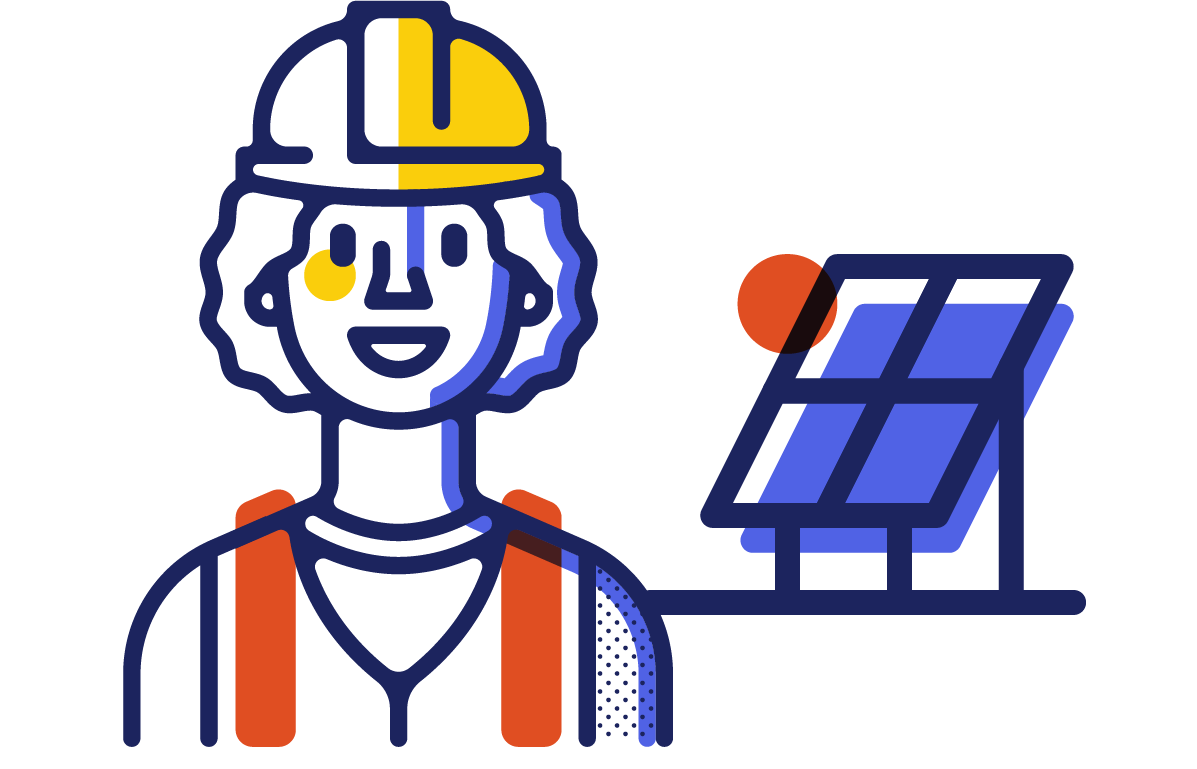What is Community Solar?
Community Solar allows eligible participants, also called subscribers, to benefit from solar energy without installing panels on their own properties.
What is a Community Solar project?
 Community Solar allows members of a community to subscribe to a single solar array. A solar array is installed at a site served by your local electrical utility. Anyone with an electricity account with that utility and is eligible for the program can subscribe to shares of that array.
Community Solar allows members of a community to subscribe to a single solar array. A solar array is installed at a site served by your local electrical utility. Anyone with an electricity account with that utility and is eligible for the program can subscribe to shares of that array.
 Your electricity supplier will credit the electricity accounts of all subscribers based on their share of the electricity generated by the array.
Your electricity supplier will credit the electricity accounts of all subscribers based on their share of the electricity generated by the array.
 Credits that subscribers see on their bill can vary by the subscriber but typically include the value of their energy supply. With ILSFA, all participating subscribers will see savings.
Credits that subscribers see on their bill can vary by the subscriber but typically include the value of their energy supply. With ILSFA, all participating subscribers will see savings.
How does the Community Solar program work?
The Community Solar program provides access to the benefits of solar energy without installing panels on-site to income-eligible households, as well as qualified non-profits and public facilities. This is made possible by providing incentives to the Approved Vendors who develop the Community Solar projects, allowing them to pass along savings to participants.
The incentives that Approved Vendors receive come from selling Renewable Energy Credits (RECs). RECs represent the environmental value of the electricity generated from solar panels, but not the electricity itself. ILSFA Approved Vendors are paid by the sale of the system’s RECs, which enables the Approved Vendor to pass along savings to the program participant.
The application process for Approved Vendors seeking to participate in the program is highly competitive.
Details on the value of Renewable Energy Credit (REC) payments can be found here.
Who can participate in Illinois Solar For All’s Low-Income Community Solar program?
Income-eligible renters and homeowners can participate. Non-profit organizations and public facilities may also participate as anchor tenants for a Community Solar project. Anchor tenants subscribe to a large share of the solar project and receive electricity credits on their electricity bills. Participants can only subscribe to Community Solar projects within their utility service territory.
- Renters and homeowners interested in subscribing to a project can look for a Community Solar subscription (suscripción Solar Comunitaria) in their utility territory and contact the Approved Vendor. Check if you’re income-eligible for the Community Solar program.
- Non-profit organizations and public facilities interested in serving as anchor tenants should contact an Approved Vendor. Unlike individual subscribers, who subscribe to a project once it is funded and producing energy, anchor tenants need to be identified during the project development process prior to the project’s submission for review. Submitted projects are reviewed by the Program Administrator and selected based on the Project Selection Protocol.
Households that do not qualify for ILSFA can subscribe to the Community Solar projects array through another solar incentive program, Illinois Shines. For more information about Illinois Shines, visit IllinoisShines.com/.
What are the benefits to the participants in the Community Solar program?
The program allows subscribers to benefit from solar energy without having to install solar panels on their property. Income-eligible participants that subscribe to a Community Solar project will have no upfront costs and any ongoing costs or fees will not be more than 50% of the value participants get from their system. (For example, if a participant receives $100 worth of electricity credits from their system in a month, their Approved Vendor cannot charge them more than $50 that month.)
Additional information can be found in the Community Solar brochure (Folleto Solar Comunitaria).
How can non-profit organizations and public facilities participate as anchor tenants?
Non-profit organizations and public facilities can subscribe as anchor tenants to a Community Solar project. Anchor tenants are subscribers that have a larger portion of the solar project, but not more than 40% of it. Non-profit organizations and public facilities serving as anchor tenants may also host the Community Solar project on their property, though this is not required in order to subscribe as an anchor tenant to a Community Solar project. Anchor tenants are required to be identified during project development.
Community Solar projects will need to meet the following criteria and site suitability requirements:
- The project must demonstrate community engagement through community outreach, education, and recruitment.
- The project applicant must list community-based organization partners in support of the project.
- The Approved Vendor will work with non-profit organizations and public facilities to meet this requirement.
For roof installations:
- The roof must be in good condition and will not need to be replaced within 15 years.
- The roof should be relatively free from shading or other obstructions.
- A modern electrical panel must be present.
For ground mount installations:
- The foundation will need to be able to support the solar array.
- The foundation cannot be a high flood risk.
This is not an exhaustive list of requirements; a complete site assessment will need to be conducted by an ILSFA Approved Vendor. If the facility does not currently have a newer roof or electrical panel but plans to install one soon, make sure to let your Approved Vendor know. ILSFA solar projects must be submitted by an Approved Vendor and meet all consumer protection guidelines and other program requirements as outlined in the Approved Vendor Manual. Non-profit organizations and public facilities interested in becoming anchor tenants and/or hosting a Community Solar project should contact an Approved Vendor.